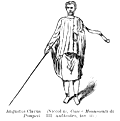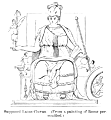Clavus Latus—Clavus Angustus
The
clavus was a stripe of purple colour, worn by the Romans as a
badge of distinction, and either sewn to the stuff or woven into it.
The latus clavus (broad stripe) was, according to tradition,
introduced by Tullus Hostilius from the Etruscans (
Plin. H.
N. ix. 136). It was the distinctive badge of the senatorial order (
Hor. Sat. i. 6, 28), and hence it is used to signify
the senatorial dignity. In distinction to the
angustus clavus it is
called
purpura maior (
Juv.i. 106), and the
garment it decorated,
tunica potens (
Stat.
Silv. v. 2, 29). Pliny speaks of this distinctive use as late (
Pliny H. N. xxxiii. 29); yet its assumption by a
praeco, the father of L. Aelius Stilo Praeconinus (whose official dress
may have included the
angustus clavus), was, as he admits, remarkable, as
was also its use by Horace's praetor of Fundi (
Sat. i. 5, 36). But there were relaxations of the restriction: thus
Augustus wore the
tunica lati clavi before he assumed the
toga virilis, and it was afterward his custom to permit the sons of senators to wear
it and attend the discussions of the Senate in order to train them in public affairs. If they
were entering on a military career, he also made them military tribunes and prefects. These
youths were called
laticlavii (
Suet.
Aug. 38;
Suet. Aug., 94); on the
contrary,
tribunus angusticlavius (
Suet.
Otho, 10). Wearing the
latus clavus was also
granted by the emperor as a favour to the sons of knights, as a preliminary step to their
entering the Senate; if they relinquished or were disappointed in their hopes, they assumed
the
angustus clavus (
Suet. Vesp.
2), but might again assume the
latus clavus, like Priscus in
Horace (
Sat. ii. 7, 10). In the later Empire the
equites
appear to have encroached on the rights of the Senate in this respect, and Alexander Severus
was only able to insist that knights should be distinguished from senators by the quality of
the purple employed (Lamprid.
Alex. Sev. 27). The Senate laid aside the
latus clavus at times of mourning (
Liv.ix. 7) and
assumed the
angustus clavus (Dio Cass. xxxviii. 14).
The
angustus clavus (narrow stripe) was a
badge of the equestrian order (Vell. Paterc. ii. 88, 2), but less distinctively so than the
golden ring (
Plin. H. N. xxxiii. 29); for, as
we shall see from the extant works of art, it was also worn by
camilli,
lanistae, and others not of equestrian rank, as a part of their ceremonial dress.
Form.—It is agreed that the
clavi
were purple stripes woven in the fabric (
Quint.viii. 5, 28) or sewn on it (
Dig. 34, 2, 23.1); that they
were employed to ornament the tunic, and no other garment; that the
angustus
clavus consisted of two narrow vertical stripes falling from each shoulder, down the
front, and, as appears from frescoes, also down the back. But there has been great discussion
concerning the form of the
latus clavus, some contending that it was a
single stripe running down the centre of the bosom of the
tunica, some
that there were two stripes, only differing from the
angustus clavus in
breadth, and, like it,
 |
|
Angustus Clavus. (Niccolini, Case e Monumenti di Pompeii. III.
Anfiteatro, tav. iii.)
|
running down the back (as Marquardt maintains). The latter view is now generally
held, although it is impossible to conclude the discussion by appealing to any representation
of a senator displaying this
ornamentum, as it was not the custom of
ancient sculptors to indicate a distinction of colour by a conventional system of lines.
It must be observed that
latus clavus, angustus clavus, are often
abbreviated expressions for
tunica lati or
angusti
clavi. Thus Iulius Caesar is said to have worn a
latus clavus ad manus
fimbriatus (
Iul. 45). That the
angustus clavus
consisted of two stripes is proved by Quintilian, xi. 3, 138:
Cui lati clavi ius non
erit, ita cingatur, ut tunicae prioribus oris infra genua paulum, posterioribus ad medios
poplites usque perveniant . . . ut purpuriae recte descendant, levis cura est. Though
we cannot point to the representation of an
eques wearing this garb, we
find it frequently shown in Pompeian paintings of persons of inferior rank who are in
ceremonial dress, especially
camilli and other attendants on
 |
|
Angustus Clavus. (From figures in the Catacombs.)
|
religious rites, and of
lanistae. In a wallpainting at Pompeii
belonging to the worship of the goddess Epona, the two
camilli and a man
leading mules wear the
angustus clavus. The latter may be a muleteer
especially adorned for a festival of the goddess, or a person of higher rank performing some rite of her worship (
Annali dell' Inst. Arch. 1872, pl.
D).
The
angustus clavus probably survives in the
clavi
on the dalmatic, which was recognized as an ecclesiastical garb in the earlier part of the
fourth century (
Vita Sylvestri I., p. 266, Combéfis), though down to
A.D. 640 the
clavi are always represented as black, according to Marriott
(
Vestiarium Christianum, p. lv.).
Some writers maintain that the drawing below, representing Rome personified, clothed in a
robe called
cyclas (q. v.), shows the
latus clavus
falling in a broad purple stripe down the breast.
It is true that the singular (
latus clavus) is generally used, but this
is also true of the
angustus clavus, which confessedly consisted of two
stripes; while the employment of the plural,
latis clavis, is striking in
a passage of Varro, which also insists on the resemblance of the two garments, by using as an
illustration of an analogy a tunic, in which of the two pieces (front and back) one has the
lati, the other the
angusti, clavi. (
Non, si
quis tunicam in usu ita [E. Schulze,
inusitate] consuit, ut altera
plagula sit angustis clavis, altera latis, utraque pars in suo genere caret, analogia
[
L. L. ix. 79]. Cf. for the use of the plural, Festus, p. 209 a, 23:
tunica autem palmata a latitudine clavorum dicebatur, quae nunc a genere picturae
appellatur.) Again, Augustus, among other affectations of simplicity,
usus est . . . clavo nec lato nec angusto (
Suet.
Aug. 73), which is quite intelligible if the two ornaments differed
only in breadth, but inexplicable on the other hypothesis; while Herodian (v. 5, 9) speaks of
the
 |
|
Supposed Latus Clavus. (From a painting of Rome personified.)
|
stripe down the centre of the tunic worn by the priests of the Sun, instituted by
Elagabalus, as a Phœnician custom.
As the tunic was composed of a front piece and a back piece sewn together, the passage
quoted above from Varro goes to show that the
lati clavi were worn down
the back as well as down the front. In support of this may be cited Varro,
Sat.
Menipp. 313, Bücheler:
quorum vitreae togae ostentant tunicae
clavos, which refers to togas made of such diaphanous material that the
clavi could be seen through them at the back. With the same intent of displaying this
mark of distinction, the wearer of the
tunica laticlavia is to gird
himself so that it may fall low (
Quint.xi. 3.139).
Pliny observes that in his time it was becoming a fashion to weave the
tunica
lati clavi of a stuff resembling
gausapa (
Pliny H. N. viii. 193). The false derivation
quoted from Festus above for
palmata as applied to
tunica may possibly indicate that the breadth of the
latus clavus
was about a palm.
The equivalents used in the Greek writers are:
clavus,
σημεῖον:
tunica laticlavia,
ἡ πλατύσημος:
tunica angusticlavia,
ἡ στενόσημος:
tunica asema (Lamprid.
Alex. Sev. 33, 4),
ἡ ἄσημος:
tunica clavata,
ἡ σημειωτός. See
Tunica.
The chief authorities for the subject are Ferrarius,
De Re Vestiaria
(Padua, 1654); Rubenius,
De Re Vestiaria Veterum Praecipue de Lato Clavo
Libri Duo (Antwerp, 1665); Ferrarius,
Analecta de Re
Vestiaria (Padua, 1690);
Marquardt, Röm.
Privatleben (1886), pp. 544 foll.; id.
Historia Equitum Rom.
pp. 77, 80; E. Schulze, in
Rhein. Mus. (1875), pp. 120 foll. See
also Hope,
The Costume of the Ancients (2d ed. 1875); Racinet,
Le Costume Historique, vol. ii.
(1887).







